Must Know High School Biology - Kellie Ploeger Cox 2019
PART THREE Genetics
Mendelian Genetics
MUST ![]() KNOW
KNOW
![]() Mendelian genetics enables us to predict what is possible when two organisms create offspring.
Mendelian genetics enables us to predict what is possible when two organisms create offspring.
![]() A Punnett square is a model for the different traits possible from a given set of parents.
A Punnett square is a model for the different traits possible from a given set of parents.
![]() In a dihybrid cross that takes two different genes into account, use the rule of multiplication as a quick way to calculate the odds of a particular cross.
In a dihybrid cross that takes two different genes into account, use the rule of multiplication as a quick way to calculate the odds of a particular cross.
![]() When completing a sex-linked cross, always use XX and XY in your Punnett square.
When completing a sex-linked cross, always use XX and XY in your Punnett square.
The previous chapter talked about how individuals create a ton of different combinations of gametes through the process of meiosis. This is just you, all on your own, setting up the cellular foundation for the next generation. Now let’s talk about the genetic outcome when you create offspring (with the help of another person’s gametes). Welcome to Mendelian genetics and Punnett squares!
![]()
IRL
The topic of Mendelian genetics is named after Gregor Mendel, a nineteenth-century Austrian monk who studied inheritance of pea plants. Mendel noticed that certain crosses would produce consistent ratios of traits in the offspring, and it appeared that these traits were controlled by some sort of distinct unit. It is impressive that he deduced the basic principles of inheritance and patterns of inheritance well before anyone knew genes (the “distinct units”) even existed!
In Mendelian genetics, you use what is called a Punnett square to model the different possible genetic outcomes (offspring) when two people have a baby. Punnett squares are very closely related to meiosis, because you decide what goes along one side of the square based on the possible sperm produced from the father, and along the other side, the possible eggs produced by the mother.
Before we jump into some Mendelian genetics, it would help if we look at some helpful vocabulary.
![]()
Keep in mind that each gamete (egg or sperm) will have only ONE of each chromosome from the parent, due to meiosis dividing up the two sets of chromosomes (going from a diploid cell to a haploid gamete). But when using a Punnett square, you’re not considering the entirety of a chromosome; instead, you are focusing on one (at the most two) particular gene(s). The same rules apply, though. When forming gametes, only one of each given gene ends up in a sperm or egg.
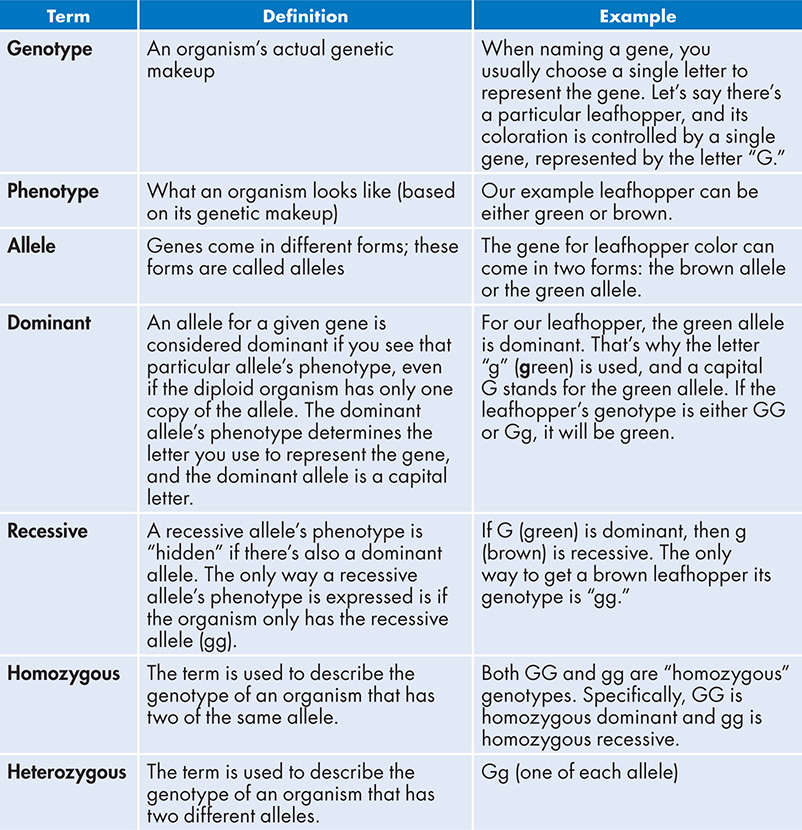
Let’s dive right into an example.
EXAMPLE
![]() A male brown leafhopper is crossed with a green heterozygous female leafhopper. What is the expected genotypic and phenotypic ratios of their offspring?
A male brown leafhopper is crossed with a green heterozygous female leafhopper. What is the expected genotypic and phenotypic ratios of their offspring?
![]() It’s a good idea to start with writing the genotypes of the parents. A brown leafhopper has the recessive phenotype, so its genotype must be gg (homozygous recessive). The other parent is the green phenotype (which could be either the GG or Gg genotype), but it states that it’s heterozygous, so it must be Gg. Now we’re ready to create a Punnett square to see all the different combinations of leafhopper babies they can make!
It’s a good idea to start with writing the genotypes of the parents. A brown leafhopper has the recessive phenotype, so its genotype must be gg (homozygous recessive). The other parent is the green phenotype (which could be either the GG or Gg genotype), but it states that it’s heterozygous, so it must be Gg. Now we’re ready to create a Punnett square to see all the different combinations of leafhopper babies they can make!
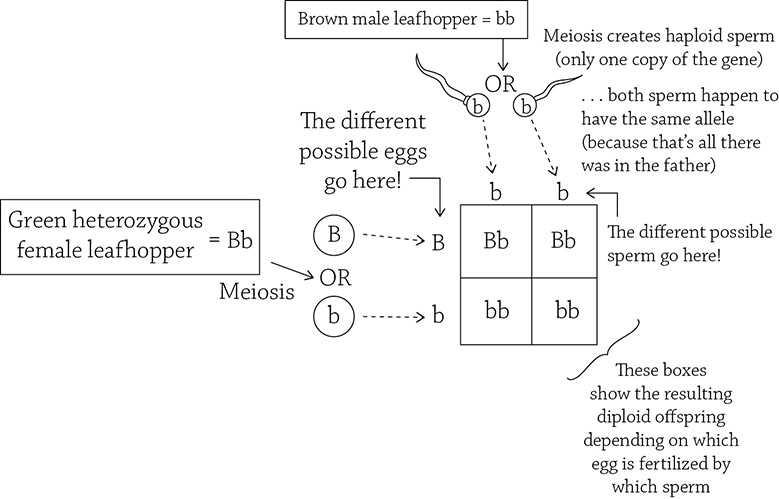
![]() Now we can answer the question! It asked both the phenotypic and genotypic ratios of the offspring, and the answer lies in your Punnett square. Half (or 50%, or 2/4) of the offspring are green, and the other half are brown. That is the phenotypic ratio, because you are describing what the offspring look like. The genotypic ratio happens to be the same, but you need to state the genotypes: half are Bb (heterozygous) and the other half are bb (homozygous recessive).
Now we can answer the question! It asked both the phenotypic and genotypic ratios of the offspring, and the answer lies in your Punnett square. Half (or 50%, or 2/4) of the offspring are green, and the other half are brown. That is the phenotypic ratio, because you are describing what the offspring look like. The genotypic ratio happens to be the same, but you need to state the genotypes: half are Bb (heterozygous) and the other half are bb (homozygous recessive).
![]() Excellent work! Ready to up the challenge a bit? What if we were tracking two different genes in this leafhopper, instead of just one? This is called a dihybrid cross (as opposed to a single-gene Punnett square problem, called a monohybrid cross). For example, there’s a different gene that determines wing shape: rounded wings (R) are dominant to sharp wings (r).
Excellent work! Ready to up the challenge a bit? What if we were tracking two different genes in this leafhopper, instead of just one? This is called a dihybrid cross (as opposed to a single-gene Punnett square problem, called a monohybrid cross). For example, there’s a different gene that determines wing shape: rounded wings (R) are dominant to sharp wings (r).
Let’s try another example:
EXAMPLE
![]() A female green leafhopper with rounded wings (heterozygous for both traits) crosses with a male green (heterozygous) leafhopper with sharp wings. What are the odds that they will produce a green offspring with sharp wings?
A female green leafhopper with rounded wings (heterozygous for both traits) crosses with a male green (heterozygous) leafhopper with sharp wings. What are the odds that they will produce a green offspring with sharp wings?
![]() First, do not panic. There’s a lot of information thrown at you right there, but I promise, it is no more difficult than our previous example. You simply need to clearly write out the parents’ genotypes and then create two separate Punnett squares, one for each gene (either body color or wing shape).
First, do not panic. There’s a lot of information thrown at you right there, but I promise, it is no more difficult than our previous example. You simply need to clearly write out the parents’ genotypes and then create two separate Punnett squares, one for each gene (either body color or wing shape).
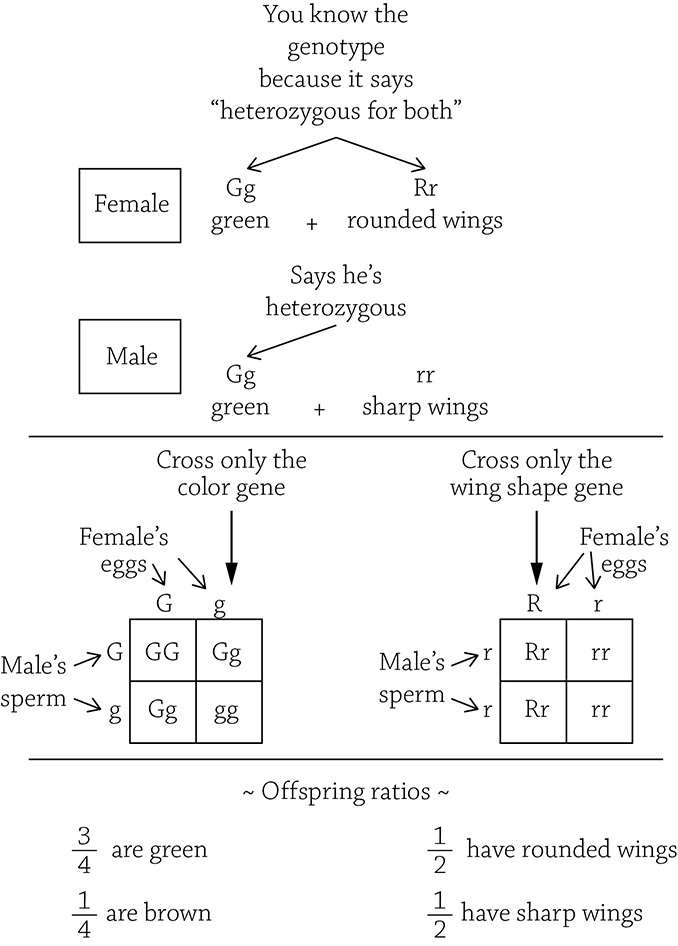
![]() Once you have all the offspring possibilities for both traits, it’s a simple matter of determining the odds that a green leafhopper will also have sharp wings. This is solved using the rule of multiplication, that states the possibility of two independent events occurring together is determined by multiplying the odds of each event occurring alone. So, for this problem, you multiply the odds of a green offspring (3/4) by the odds of a sharp-winged offspring (1/2) to get 3/8! You have a 3/8 chance of producing a sharp-winged, green baby leafhopper!
Once you have all the offspring possibilities for both traits, it’s a simple matter of determining the odds that a green leafhopper will also have sharp wings. This is solved using the rule of multiplication, that states the possibility of two independent events occurring together is determined by multiplying the odds of each event occurring alone. So, for this problem, you multiply the odds of a green offspring (3/4) by the odds of a sharp-winged offspring (1/2) to get 3/8! You have a 3/8 chance of producing a sharp-winged, green baby leafhopper!
![]()
When multiplying fractions, all you have to do is multiply the numerators together to get the numerator of the answer, and then multiply the denominators together to get the denominator of the answer:
![]()
I don’t mean to stress something that may seem obvious to you, but I can’t tell you how often my students make a silly mistake at this step, multiply their fractions incorrectly, and get the wrong final ratio!!
Sex Linkage
There’s another tricky scenario you may run into, and it’s a sex-linked gene. Recall that there is a non-homologous pair of chromosomes called the sex chromosomes: X and Y. These two chromosomes have totally different genes from one another. A female has two X chromosomes and a male has one X and one Y chromosome. A sex-linked trait is a gene that is found only on the X chromosome (and is thus “linked” to the X chromosomes). This makes a huge difference, because although females have the “normal” two copies of a sex-linked gene, males only have one copy. This changes things up quite a bit. For example, color blindness is a sex-linked trait, designated by a small superscript “c” on the X chromosomes (Xc). It is super important that when you consider a sex-linked trait, you ALWAYS track its movement on the X chromosome. The small letter c correctly suggests that it is a recessive trait; the normal color vision allele is a capital C (XC). It is a must know that when figuring out a sex-linked trait, always take XX and XY into consideration.
The odds of finding a color-blind male are much greater than a color-blind female, simply because it is a sex-linked trait. The color-blind allele is recessive, and females have two X chromosomes. Therefore, a color-blind female has two recessive color-blind alleles, one on each X chromosome:
Xc Xc
In order for a man to be color-blind, however, he needs only one recessive color-blind allele:
XcY
Without a second X chromosome, whatever genes are on a man’s X chromosomes are the ones to be expressed. A woman, however, could have a single color-blind allele and have normal vision:
XC Xc
In this case, she is referred to as a “carrier,” because she carries within her the recessive color-blind allele but has normal vision. So, let’s try a straightforward sex-linked question.
EXAMPLE
![]() What are the odds that a color-blind man and a carrier woman will have a color-blind child?
What are the odds that a color-blind man and a carrier woman will have a color-blind child?
![]() First, write the genotypes of each parent:
First, write the genotypes of each parent:
Man = XcY
Woman = XC Xc ← Remember, a carrier is a woman with one recessive sex-linked allele
Then, create a Punnett square:
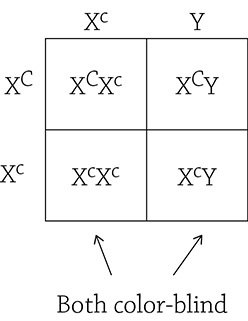
![]()
I can’t stress this enough: Whenever you are doing a sex-linked cross, always first indicate the sex chromosomes: XX or XY. If you forget to take this into consideration and instead just write “Cc” for example, you won’t get the correct answer.
![]() The answer is these two people would have a 50% chance of having a color-blind kid! Specifically, there is a 1 in 2 chance of a girl being color-blind, and a 1 in 2 chance of a boy being color-blind.
The answer is these two people would have a 50% chance of having a color-blind kid! Specifically, there is a 1 in 2 chance of a girl being color-blind, and a 1 in 2 chance of a boy being color-blind.
Make sense? Okay, let’s try a more difficult example.
EXAMPLE
![]() Hemophilia is a sex-linked trait where an afflicted person’s blood does not clot properly. Sunny has normal blood clotting (although her own mother was a hemophiliac), and has a baby with Maynard, also with normal blood clotting. What are the odds that their child will have hemophilia?
Hemophilia is a sex-linked trait where an afflicted person’s blood does not clot properly. Sunny has normal blood clotting (although her own mother was a hemophiliac), and has a baby with Maynard, also with normal blood clotting. What are the odds that their child will have hemophilia?
![]() In this scenario, both Sunny and Maynard have normal clotting. You know, therefore, that Maynard must be XBY, where B indicates a normal blood clotting gene. At first, you don’t know about Sunny, who is described as also being normal … but her own mom has hemophilia! So first you can determine Sunny’s genotype …
In this scenario, both Sunny and Maynard have normal clotting. You know, therefore, that Maynard must be XBY, where B indicates a normal blood clotting gene. At first, you don’t know about Sunny, who is described as also being normal … but her own mom has hemophilia! So first you can determine Sunny’s genotype …
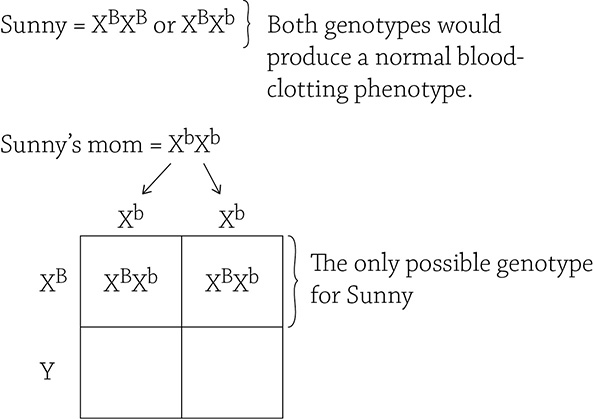
… and now you can see what the kids of Sunny and Maynard would be:
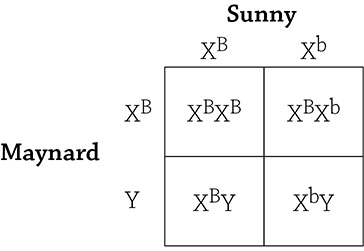
![]() The answer to the question “what are the odds that their child will have hemophilia?” is 25%. One out of the four possibilities (the XbY boy) would have hemophilia.
The answer to the question “what are the odds that their child will have hemophilia?” is 25%. One out of the four possibilities (the XbY boy) would have hemophilia.
REVIEW QUESTIONS
1. Match the following term with the correct definition:
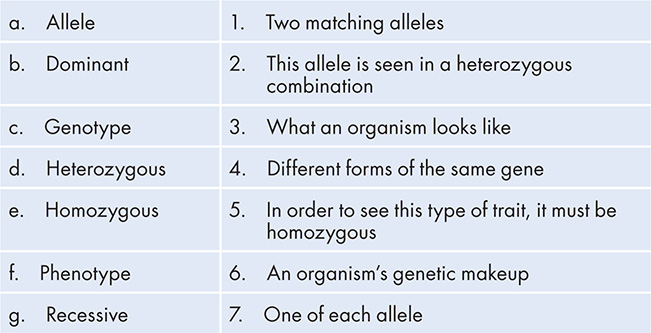
2. Fruit fly (Drosophila melanogaster) eyes are normally red, but there is a recessive allele that makes them appear dark (ebony). If a heterozygous red-eyed fly is crossed with a fly with ebony eyes, what percentage of offspring will have the recessive phenotype?
3. In cats, brown fur (B) is dominant to white fur (b), and short fur (S) is dominant to long fur (s). What are the odds that a cross between a male cat heterozygous for both traits and a white, short-haired female (who is heterozygous for fur length) will produce a kitten with white, long fur?
4. A man with normal color vision marries a woman who also has normal color vision. Her father was color-blind. What are the chances that their child will be color-blind?
5. A plant with purple flowers crosses with a plant with white flowers. All the offspring produce purple flowers. Based on this description, which flower color allele (white or purple) is dominant and which is recessive?
6. True or False: When a homozygous dominant trait is crossed with a homozygous recessive trait, the phenotypic ratio in the offspring will always be 100% recessive phenotype.
7. In chickens, brown feathers (B) are dominant to white feathers (b) and large combs (L) are dominant to small combs (l). If a white rooster that is heterozygous for large combs mates with a hen that is heterozygous for both traits, what are the odds of producing a white chicken with a large comb?
8. If a color-blind man has a baby with a woman who is homozygous for normal vision, what are their chances of having a daughter who is a carrier for color blindness?
